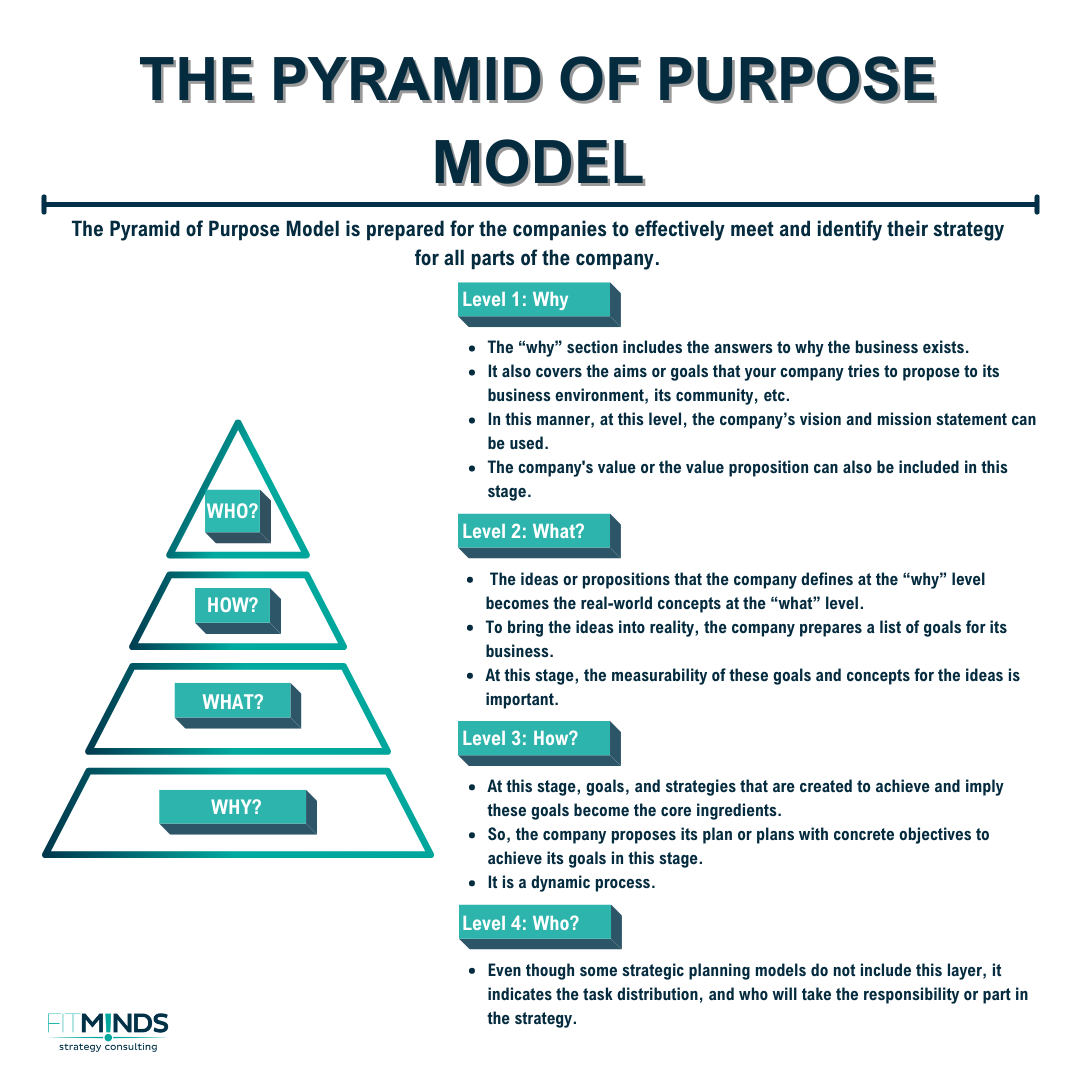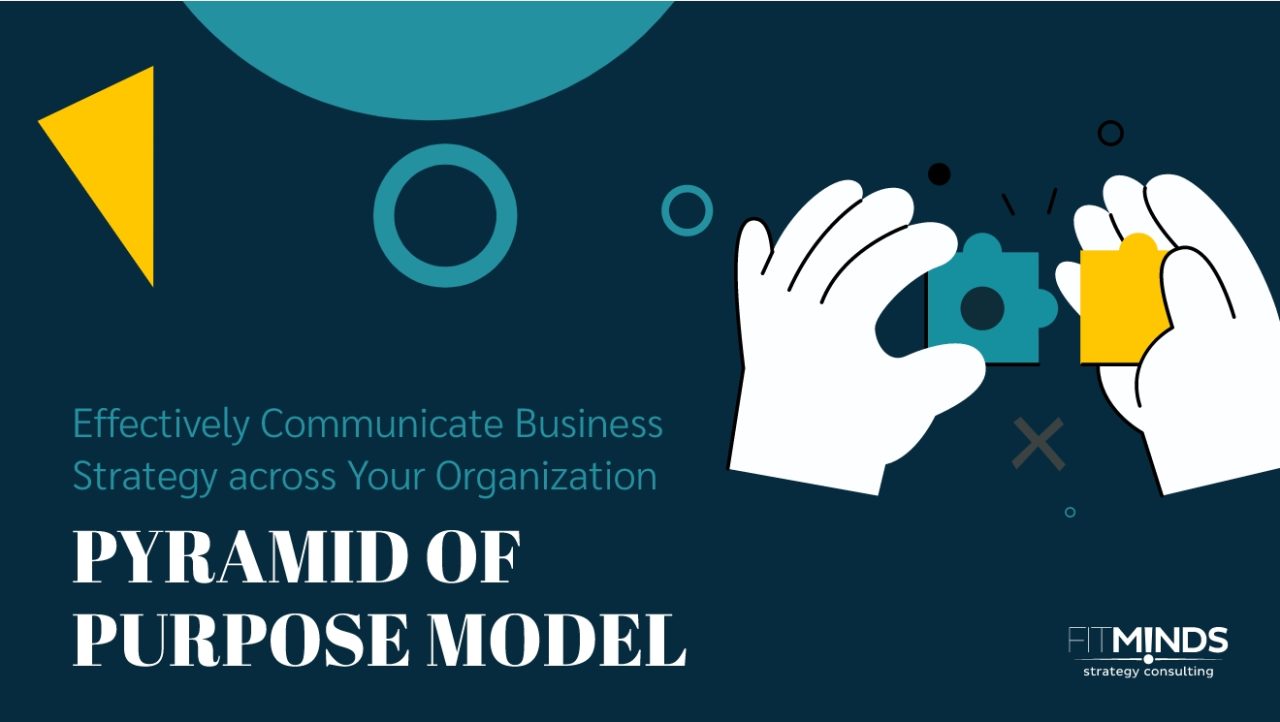All around the world, one of the crucial needs of companies is the adoption of their strategies across all parts of their organizations. For this, the Pyramid of Purpose Model is developed as a strategic tool that meets this need of the companies. The Pyramid of Purpose Model is prepared for the companies to effectively meet and identify their strategy for all parts of the company.
Main Benefits of the Pyramid of Purpose Model
The Pyramid of Purpose Model assists companies to build communication channels to inform all parts of the companies about the strategies that will be conducted. In this manner, it improves the communication channels of the company, rises the acceptance of the strategies by your business environment, increases the efficiency with the fluent implication of strategies across the companies, and increases the profitability.
The Pyramid of Purpose Model helps you:
- To build communication channels across the company
- To improve the inside communication of the company
- To rise the acceptance of the strategies by all parts of the companies
- To increase efficiencies of strategies’ implications
- To increase the profitability
Explanation of the Pyramid of Purpose Model:
The Pyramid of Purpose Model consists of four levels listed down top according to their implication order. These stages are: Why, What, How, and Who from down to top. In this part, we will go through each of these stages with a piece of detailed information.

Level 1: Why?
The “Why” section of the pyramid lies at the bottom of the pyramid, and it is the first level of the model. The reason behind it can be explained as the importance of the step. The “why” section includes the answers to why the business exists. It also covers the aims or goals that your company tries to propose to its business environment, its community, etc. In this manner, at this level, the company’s vision and mission statement can be used. The company’s value or the value proposition can also be included in this stage. Let’s go over these statements and their definitions.
- Vision: The vision statement covers what the company offers to its customers, stakeholders, etc. in general the company’s business environment. In other words, the vision statement shows your company’s perspective to its business environment.
- Mission: The mission statement indicates the meaning of your company. The mission statement engages with the vision statement, and it shows the way that how your company will pursue its vision statement.
- Values: The values of the company improve the vision and mission statement of the company. Values cover the core things that the business contains while running its business and the things that do not cover by the company in the business process. Values make unique the companies in terms of fulfilling their vision and mission.
The vision, mission statements, and values of the companies are important to keep in mind for the companies’ audiences. It also assists the companies’ strategy indication to their business environments. The companies also consider their targeted audiences’ opinions and thoughts when they are answering the question “why” at this level, also for these statements and values.
Level 2: What?
After the “why” level, the “what” level comes in the model. In the “what” level, the needed answers are more tangible and away from abstract ideas. The ideas or propositions that the company defines at the “why” level becomes the real-world concepts at the “what” level. So, at this level, the “why” level is introduced to the real world through the “what” level. To bring the ideas into reality, the company prepares a list of goals for its business. At this stage, the measurability of these goals and concepts for the ideas is important. Also, they need to be actionable and applicable to believe your business environment. Besides, the company needs to show its effort to imply the answer at this stage. When the company becomes successful to achieve its goals, not necessarily all of them, the company needs to announce this success. Lastly, for this stage, one of the necessary and crucial talents is the proper goal-setting ability. Goal setting is crucial to bring ideas into reality.
Level 3: How?
The third layer in the Pyramid of Purpose Model is the “how” level. In the correct order, the company is settled on its mission, vision, and values, the way that the company position itself in front of its targeted audiences. Then, at the “what” level, these abstract ideas turn into concepts to bring them into the real world. In the “how” section, the measurability, applicability, and actionability increase. At this stage, goals, and strategies that are created to achieve and imply these goals become the core ingredients. So, the company proposes its plan or plans with concrete objectives to achieve its goals in this stage. It is a dynamic process, it contains revisions and revisits of the goals, and strategies even if the core ideas such as the vision and mission statement of the company. The baseline is the execution process and the strategic planning. It is ongoing because the “how” level supports the company to go further. To make this level clearer, we will go over the short definitions of goals and strategy in the business world.
- Goals: The things that the companies highlighted in their vision statement turn into reality if these companies set proper and applicable goals. In that manner, goals assist the companies to achieve their vision statements. They could be short-term, mid-term, and long-term goals according to the achievability.
- Strategy: The strategy enables the companies to focus on their goals and successfully run their business with the prioritization of the goals. It also includes the elimination of the goals, prioritization of the goals, and conduction of them.
Level 4: Who?
The last layer of the Pyramid of Purpose Model is the “who” level. Even though some strategic planning models do not include this layer, it indicates the task distribution, and who will take the responsibility or part in the strategy. The “Who” step is important because without the identification of people during the allocation of responsibilities to achieve the company’s vision and mission. So, it underlines the task distribution within the company after the settlement of the strategies.
How to apply the Pyramid of Purpose Model?
To apply the Pyramid of Purpose Model, FITMINDS is providing an adoption of the Pyramid of Purpose Model Engagement Journey that fits your company and your company’s needs.
To set the right strategy that will maximize the structure, resources, and performance of your company, Organizational Structuring is your answer. Contact us to learn more about Organizational Structuring Model.
Additional Tips and Readings
- For building your corporate social responsibility, you can check Carroll’s Pyramid of CSR.
- For determining what type of strategy is right for your business, you can check Porter’s Generic Strategies.
- Craft a well-thought business strategy, you can check Lafley and Martin’s Five- Step Strategy Model.
Contact us to effectively communicate business strategy across your company via the Pyramid of Purpose Model.



13 comments
Pingback: discount enclomiphene generic from india
Pingback: kamagra à vendre
Pingback: discount androxal australia generic online
Pingback: online order flexeril cyclobenzaprine canada over the counter
Pingback: Canadian dutasteride diet pills without a perscription
Pingback: discount gabapentin generic uae
Pingback: discount itraconazole toronto canada
Pingback: generic fildena in dubai
Pingback: buy cheap staxyn price south africa
Pingback: how to order avodart price usa
Pingback: cheapest buy xifaxan generic mexico
Pingback: order rifaximin cost per tablet
Pingback: kamagra 20
Comments are closed.